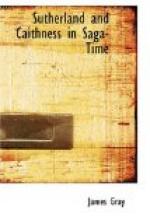After this settlement of their claims, Malcolm II died in 1034 at the age of eighty; and his death wrecked his policy. For Duncan, his grandson, the Karl Hundason of the Saga, on his accession to the Scottish throne claimed tribute from his cousin Thorfinn for Caithness. Payment was at once refused, and six years of strife, interrupted by Duncan’s unfortunate raids south of the Tweed, ended by his creating Mumtan or Moddan, his own sister’s son, Earl of Caithness instead of Thorfinn. With a force collected in Sudrland, which thus appears to have been on the Scottish side, Moddan tried to make good his title, but Thorfinn raised an army in Caithness, and Thorkel collected another for him in Orkney, and the Scots retired before superior numbers. “Then Earl Thorfinn fared after them, and laid under him Sudrland and Ross and harried far and wide over Scotland; thence he turned back to Caithness,” and “sate at Duncansby, and had there five long-ships ... and just enough force to man them well."[9]
After his retirement in Caithness, Moddan went to Duncan at North Berwick, and Duncan sent him back with another force by land to Caithness, proceeding thither himself by sea with eleven ships. Duncan caught Thorfinn and his five ships off the Mull of Deerness in the Mainland of Orkney, where, after a stiff hand-to-hand fight, the Scots fleet was defeated and chased southwards by Thorfinn to Moray, which he ravaged.[10]
Finding that Moddan and his army were in Thurso, Thorfinn sent Thorkel Fostri thither secretly with part of his forces, and he set fire to the house in which Moddan was, and killed him there as he tried to escape. Thorkel next raised levies in Caithness, Sutherland, and Ross, joined forces with Thorfinn in Moray, and harried the land, whereupon Duncan collected an army from the south of Scotland and Cantire and Ireland, and attacked his enemies in the north.
A great battle ensued near the Norse stronghold of Turfness,[11] probably Burghead, where peat is found in abundance, though now submerged; and the battle was fought at Standing Stane in the parish of Duffus, three miles and a half E.S.E. of Burghead, on the 14th of August 1040.
The Saga gives the following description of the jarl and of the fighting:—
“Earl Thorfinn was at the head of his battle array; he had a gilded helmet on his head, and was girt with a sword, a great spear in his hand, and he fought with it, striking right and left.... He went thither first where the battle of those Irish was; so hot was he with his train, that they gave way at once before him, and never afterwards got into good order again. Then Karl let them bring forward his banner to meet Thorfinn; there was a hard fight, and the end of it was that Karl laid himself out to fly, but some men say that he has fallen.”
“Earl Thorfinn drove the flight before him a long way up into Scotland, and after that he fared about far and wide over the land and laid it under him."[12]




